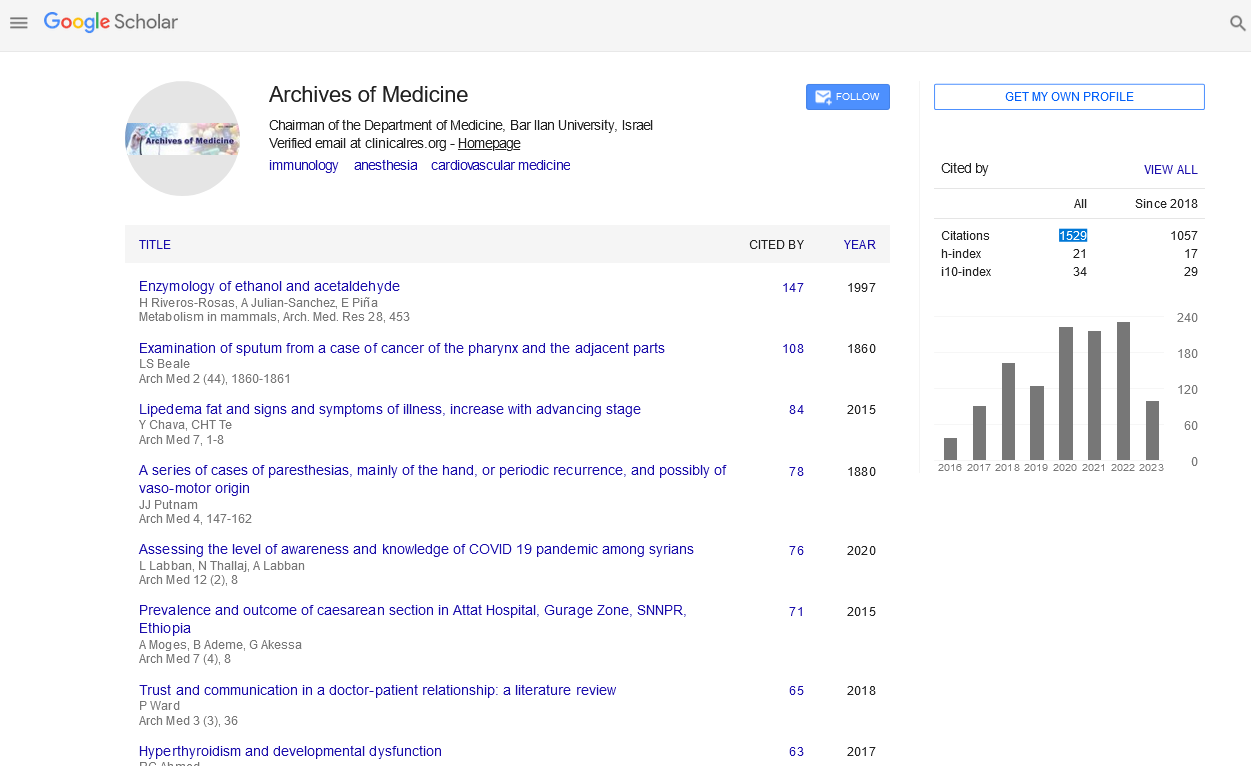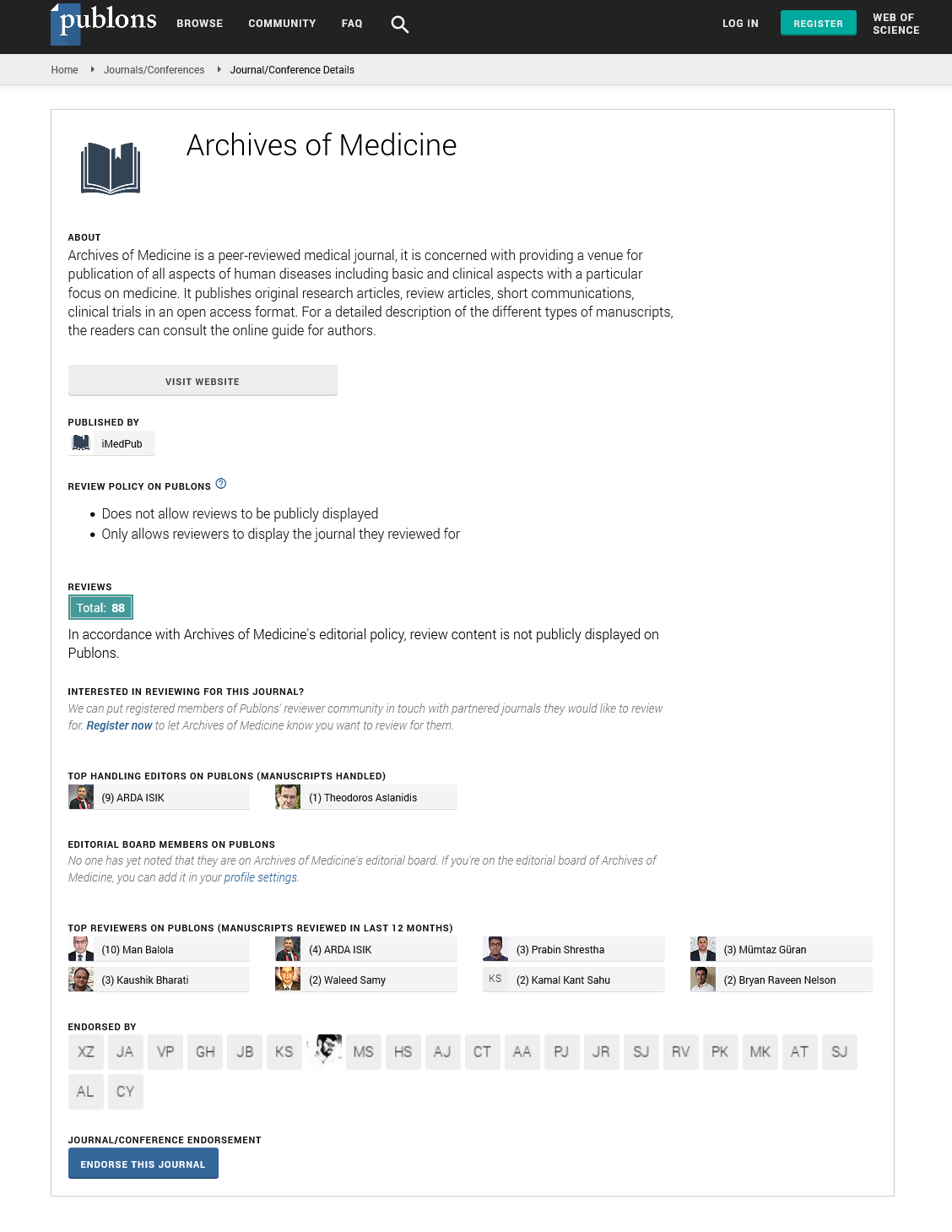Commentary - (2025) Volume 17, Issue 1
Integrated approaches in chronic disease management: A new model for internal medicine
Lukas Muller*
Department of Internal Medicine, University of Berlin, Charitéplatz, Berlin, Germany
*Correspondence:
Lukas Muller, Department of Internal Medicine, University of Berlin, Charitéplatz, Berlin,
Germany,
Email:
Received: 03-Jan-2025, Manuscript No. ipaom-24-15473;
Editor assigned: 06-Jan-2025, Pre QC No. P-15473;
Reviewed: 17-Jan-2025, QC No. Q-15473;
Revised: 22-Jan-2025, Manuscript No. R-15473;
Published:
29-Jan-2025
Introduction
Chronic diseases are among the leading causes of morbidity and mortality worldwide. Conditions such as diabetes, hypertension, heart disease, and chronic respiratory diseases account for a significant proportion of the global disease burden. The World Health Organization (WHO) has identified chronic diseases as a primary public health challenge, given their long-term, often debilitating effects on individuals, families, and healthcare systems. Traditionally, chronic disease management has been approached in a siloed manner, where each specialist focuses on a particular aspect of a patient's health. This approach, while effective for certain isolated conditions, often fails to consider the complexities that arise when patients suffer from multiple, coexisting chronic diseases. Additionally, the traditional approach tends to focus primarily on the medical and physiological aspects of disease, overlooking the critical role of psychological, social, and environmental factors in disease progression and patient outcomes. The rise of an integrated approach to chronic disease management aims to address these challenges. The integrated model promotes the idea that managing chronic conditions requires a comprehensive, patient-centered approach that considers the full spectrum of factors affecting health. By blending medical expertise with behavioral health interventions, social support, and coordinated care across disciplines, this model offers a holistic solution to the growing problem of chronic disease management [1].
This article explores the concept of integrated approaches to chronic disease management within the field of internal medicine. It highlights the benefits of a more comprehensive approach and provides a new model for managing chronic diseases that emphasizes collaboration between healthcare professionals and active patient involvement in care.
Description
The challenges of managing chronic diseases
Chronic diseases are persistent, often lifelong conditions that require long-term care. These diseases are not only physically demanding but also impose a significant psychological burden on patients, who may experience depression, anxiety, or a diminished quality of life. Furthermore, many individuals living with chronic diseases often face challenges related to socioeconomic factors such as limited access to healthcare, health literacy, and lifestyle behaviors that exacerbate the conditions. Managing multiple chronic diseases, also known as multimorbidity, is particularly challenging. Traditional models of care, which are often disease-specific, fail to address the interactions between various conditions and the patientâ??s overall health. For instance, a patient with both diabetes and heart disease may receive separate treatment plans for each condition, without adequate consideration of how these treatments might interact or impact the patientâ??s well-being as a whole. Another critical challenge in chronic disease management is the increasing complexity of treatment regimens. As patients age or develop additional conditions, the number of medications they need may increase, creating the risk of medication errors, adverse drug interactions, or non-compliance. In this context, a patient-centered, integrated approach is essential, not just for improving clinical outcomes, but for enhancing patient satisfaction and adherence to treatment [2].
The integrated approach to chronic disease management.
An integrated approach to chronic disease management moves beyond the traditional model by focusing on collaboration among a diverse set of healthcare providers. The key tenets of this approach include the coordination of care across multiple healthcare settings, the use of interdisciplinary teams, and the emphasis on patient engagement and empowerment. In this model, primary care physicians, specialists, nurses, psychologists, social workers, and other professionals work together to create an individualized care plan that addresses not only the medical needs of the patient but also their emotional, psychological, and social needs. By recognizing the patient as a whole person rather than a set of isolated conditions, integrated care aims to provide more effective, timely, and compassionate treatment. One of the cornerstones of the integrated approach is the use of a multidisciplinary team. Each member of the team brings their specialized expertise, but all are united in a shared goal: improving the overall health of the patient. For example, a patient with heart failure and depression may receive treatment from a cardiologist for their heart condition and a psychologist for their mental health, with both providers coordinating care to ensure that the treatments do not interfere with one another [3].
Additionally, patient-centered care is central to the integrated model. This approach actively involves the patient in decision-making and encourages self-management of their condition. Patients are encouraged to set goals, understand their disease, and participate in the creation of their treatment plans. This not only increases patient satisfaction but also improves adherence to treatment, as individuals are more likely to follow plans they helped create and understand. An important aspect of integrated chronic disease management is the use of technology to support coordination and monitoring. Digital health tools, such as health tracking apps, telemedicine platforms, and remote monitoring devices, allow for continuous data collection and real-time updates on a patientâ??s condition. For instance, wearable devices that track blood pressure, glucose levels, or physical activity can provide healthcare providers with valuable insights into the patient's health status between visits. This continuous flow of information enables healthcare providers to make timely adjustments to treatment plans and prevent complications before they escalate. Another key feature of integrated care is behavioral health integration. Research has shown that chronic diseases and mental health conditions are closely intertwined. For example, depression and anxiety are common in patients with chronic conditions such as diabetes and heart disease, and these psychological factors can worsen the physical condition or complicate treatment. By incorporating mental health professionals into the care team, patients can receive the support they need to address psychological issues that may otherwise go untreated, leading to better overall outcomes [4,5].
Conclusion
Chronic diseases continue to pose a significant challenge to global public health, affecting millions of individuals and placing a substantial burden on healthcare systems. The traditional, fragmented approach to managing chronic conditions is increasingly recognized as inadequate in meeting the complex needs of patients. An integrated approach to chronic disease management offers a more holistic, coordinated, and patient-centered solution. By embracing collaboration among multidisciplinary teams, utilizing advanced technologies, and emphasizing patient engagement, the integrated model holds the potential to revolutionize chronic disease care. This approach not only improves clinical outcomes but also enhances the overall quality of life for patients, reduces healthcare costs, and fosters greater adherence to treatment plans. For the future of internal medicine, adopting integrated approaches to chronic disease management is not just a necessity but an opportunity to better serve patients, enhance healthcare delivery, and ultimately transform how we approach long-term care. As healthcare systems worldwide continue to evolve, the integrated model offers a promising path forward, ensuring that patients receive the comprehensive, coordinated care they deserve.
Acknowledgment
None.
Conflict of Interest
None.
References
- Epping-Jordan JE. Integrated approaches to prevention and control of chronic conditions. Kidney Int Suppl. 2005 1;68:S86-S88.
Google Scholar Cross Ref Indexed at
- Brunner-La Rocca HP, Fleischhacker L, Golubnitschaja O, et al. Challenges in personalised management of chronic diseases—heart failure as prominent example to advance the care process. EPMA J. 2016;7:1-9.
Google Scholar Cross Ref Indexed at
- Mahomed OH, Asmall S, Freeman M. An integrated chronic disease management model: A diagonal approach to health system strengthening in South Africa. J Health Care Poor Underserved. 2014;25(4):1723-1729.
Google Scholar Cross Ref Indexed at
- Clark NM, Gong M. Management of chronic disease by practitioners and patients: Are we teaching the wrong things?. BMJ. 2000 26;320(7234):572-575.
Google Scholar Cross Ref Indexed at
- Duda-SikuÅ?a M, Kurpas D. Enhancing chronic disease management: Personalized medicine insights from rural and urban general practitioner practices. J Pers Med. 2024 1;14(7):706.
Google Scholar Cross Ref Indexed at






